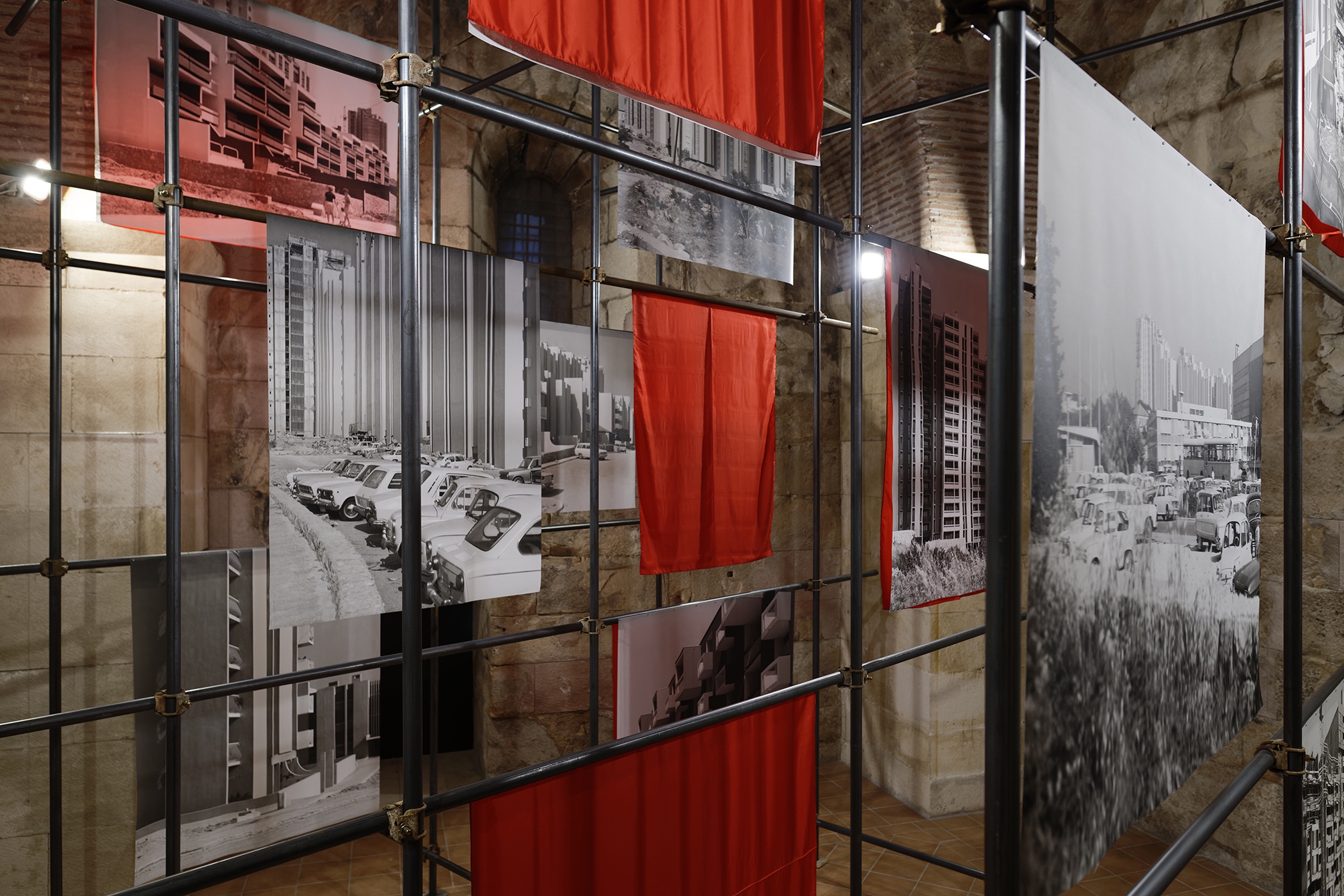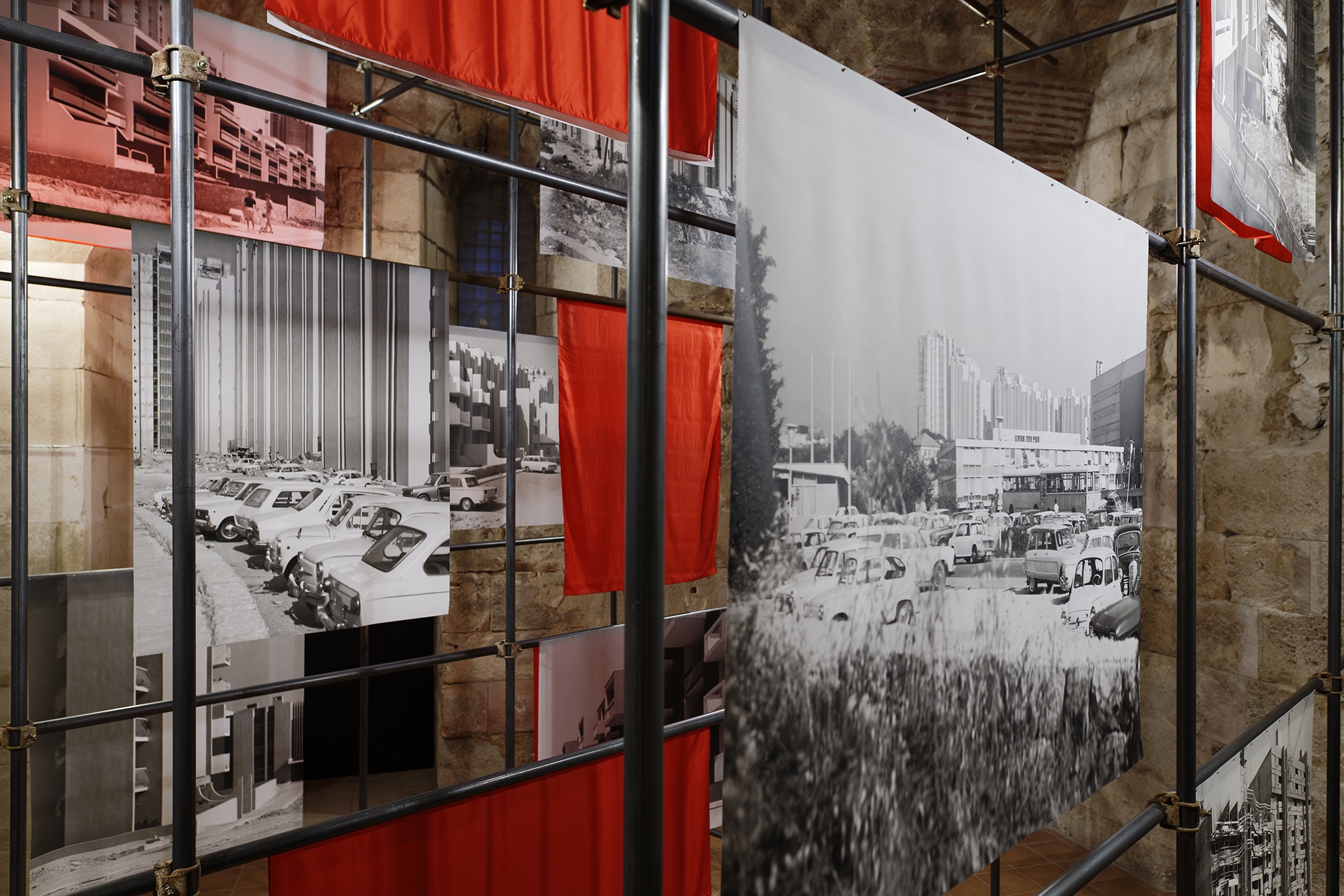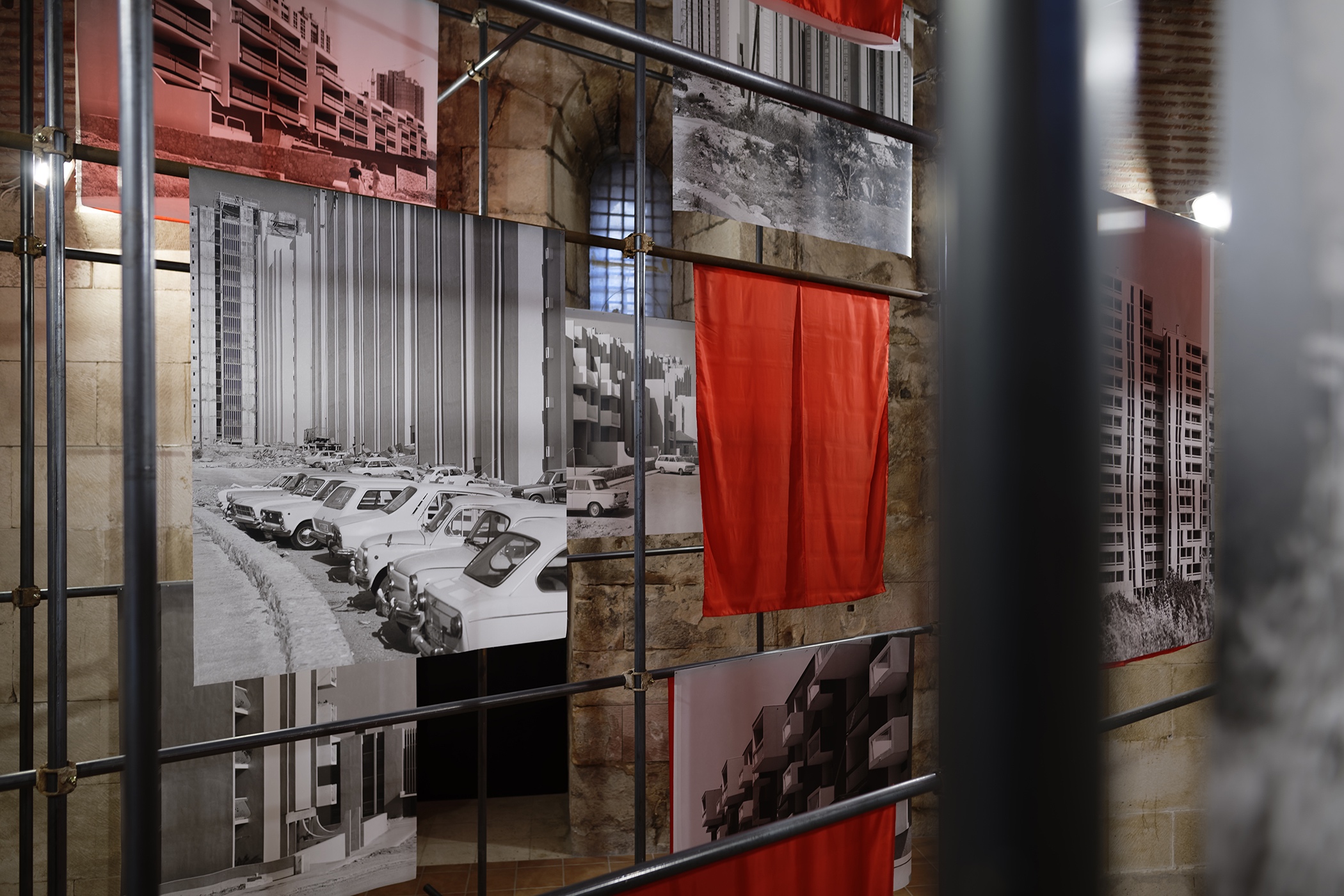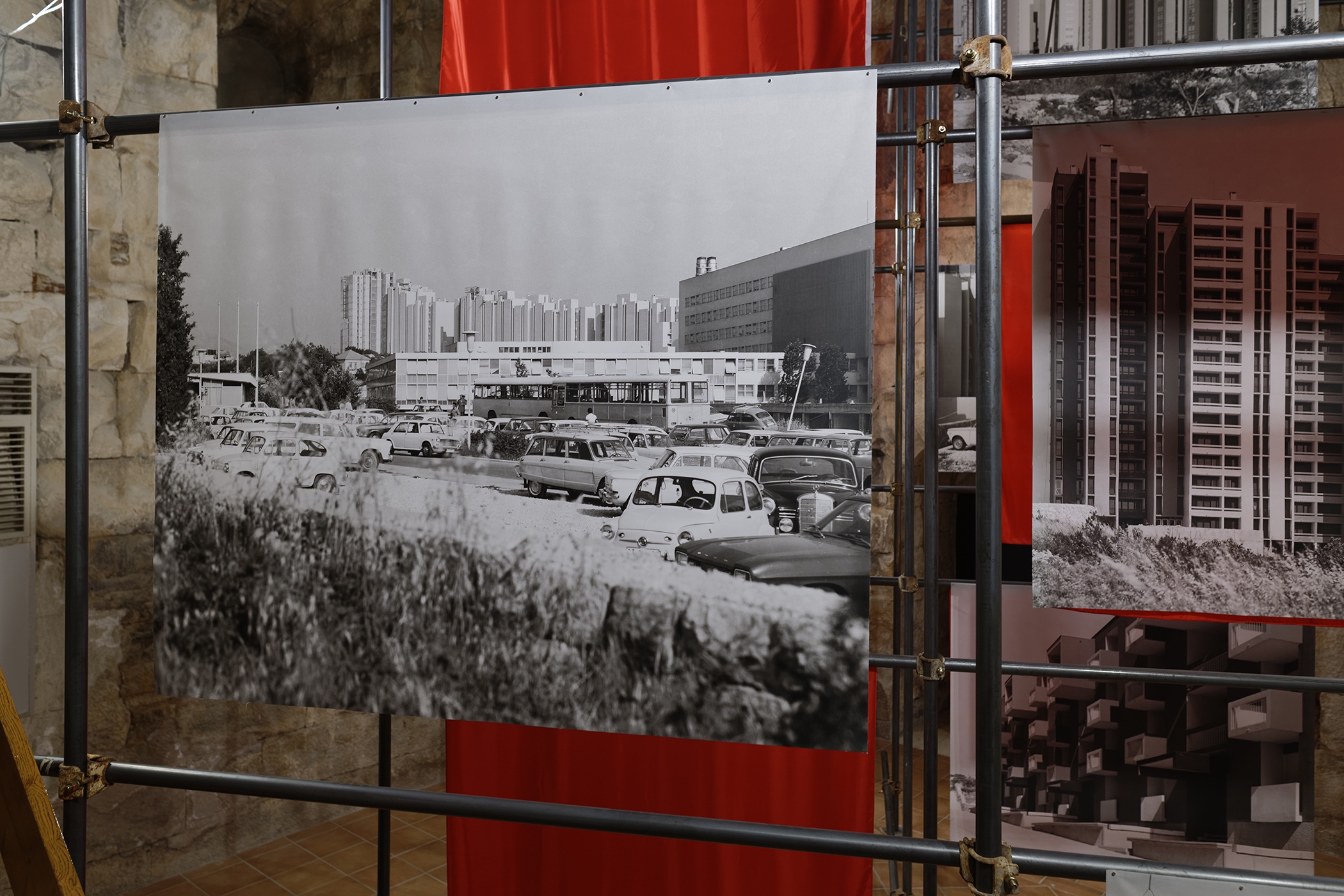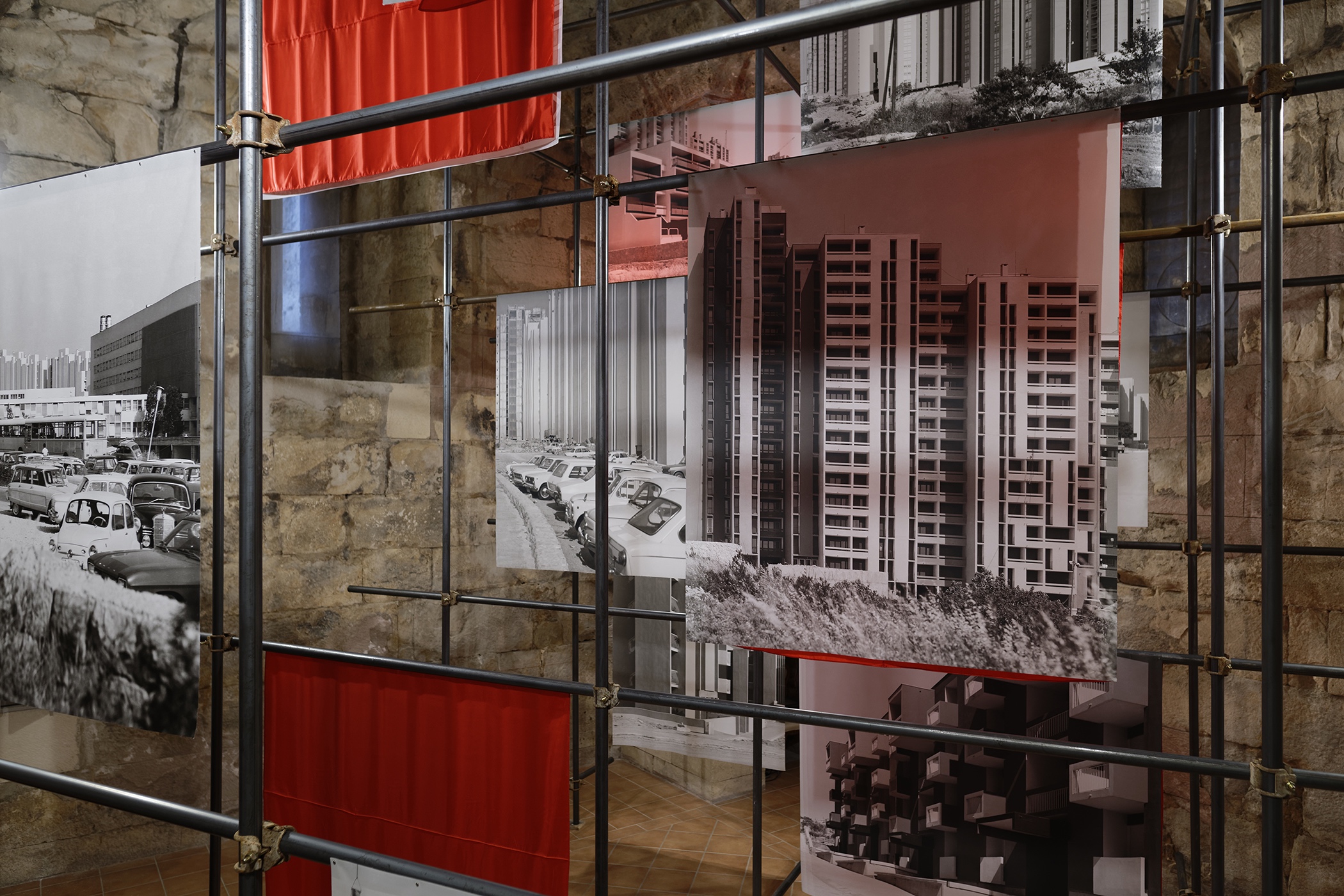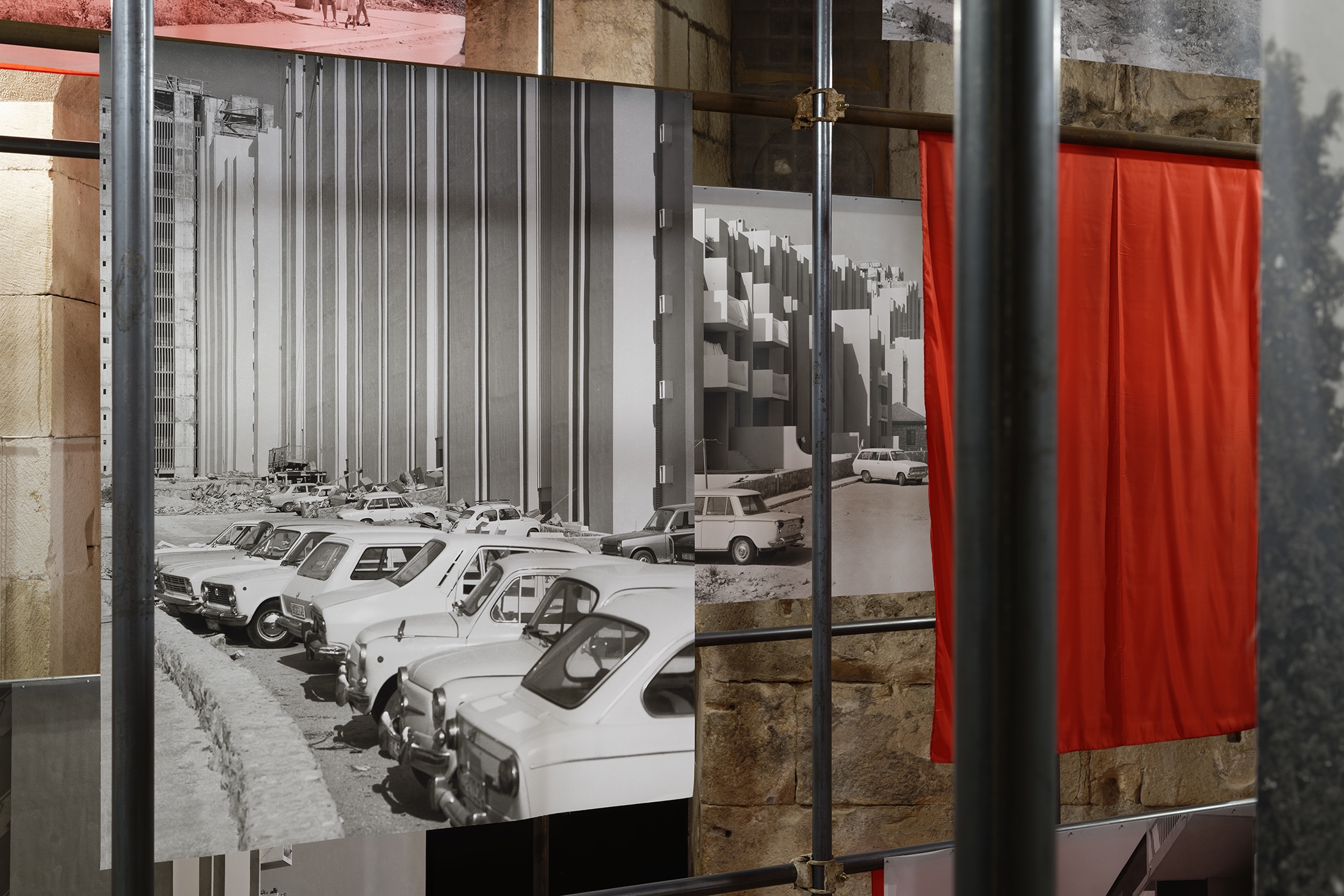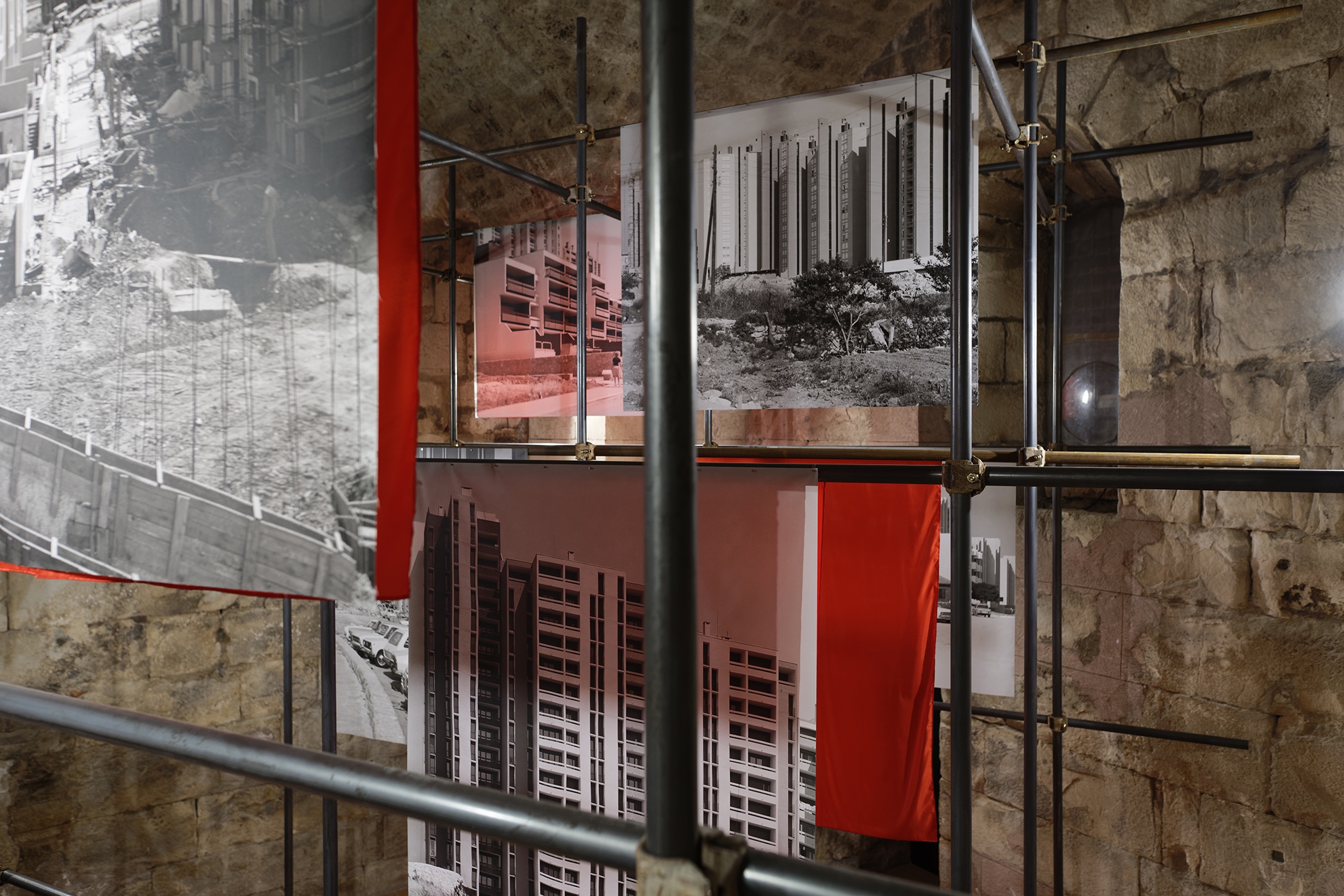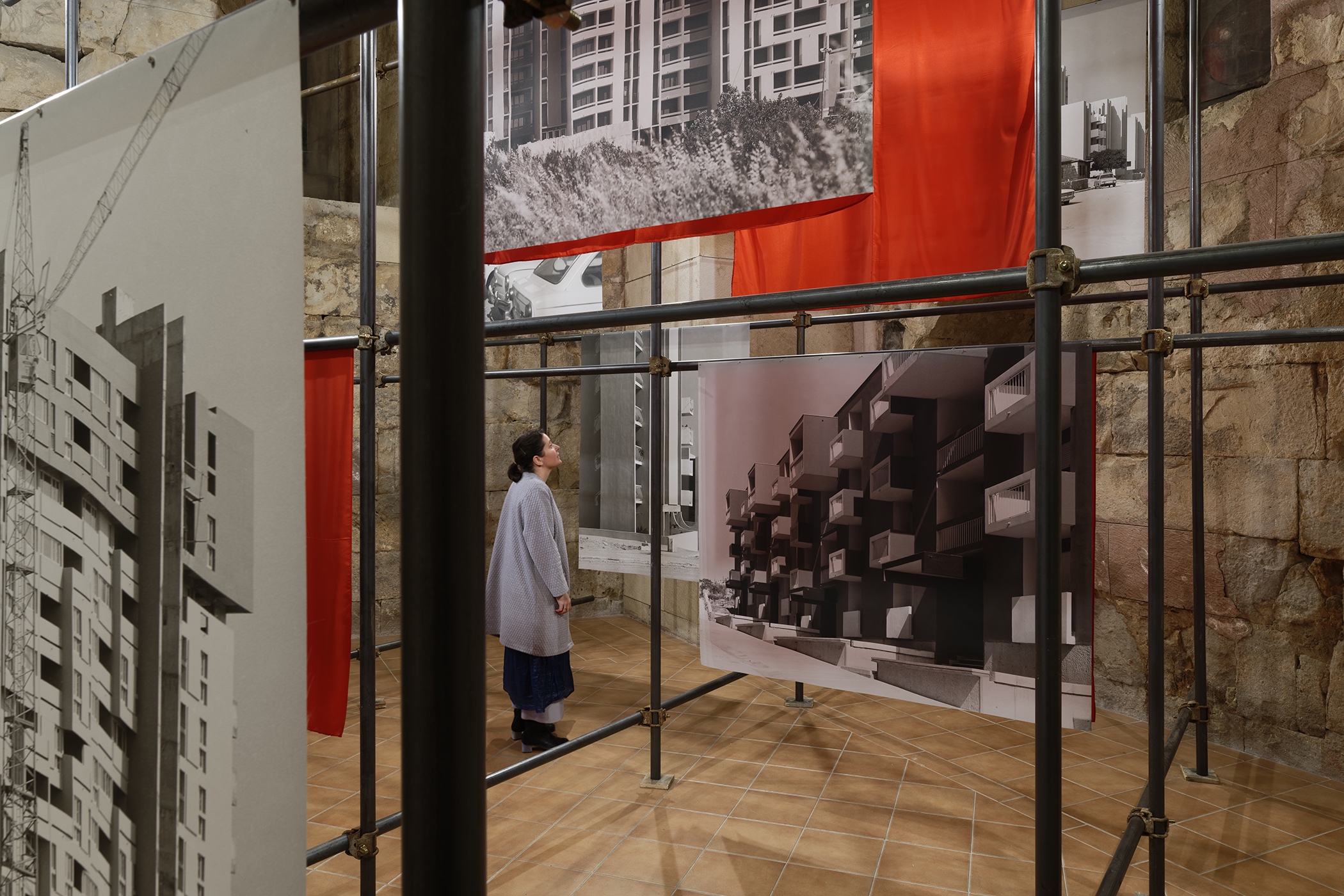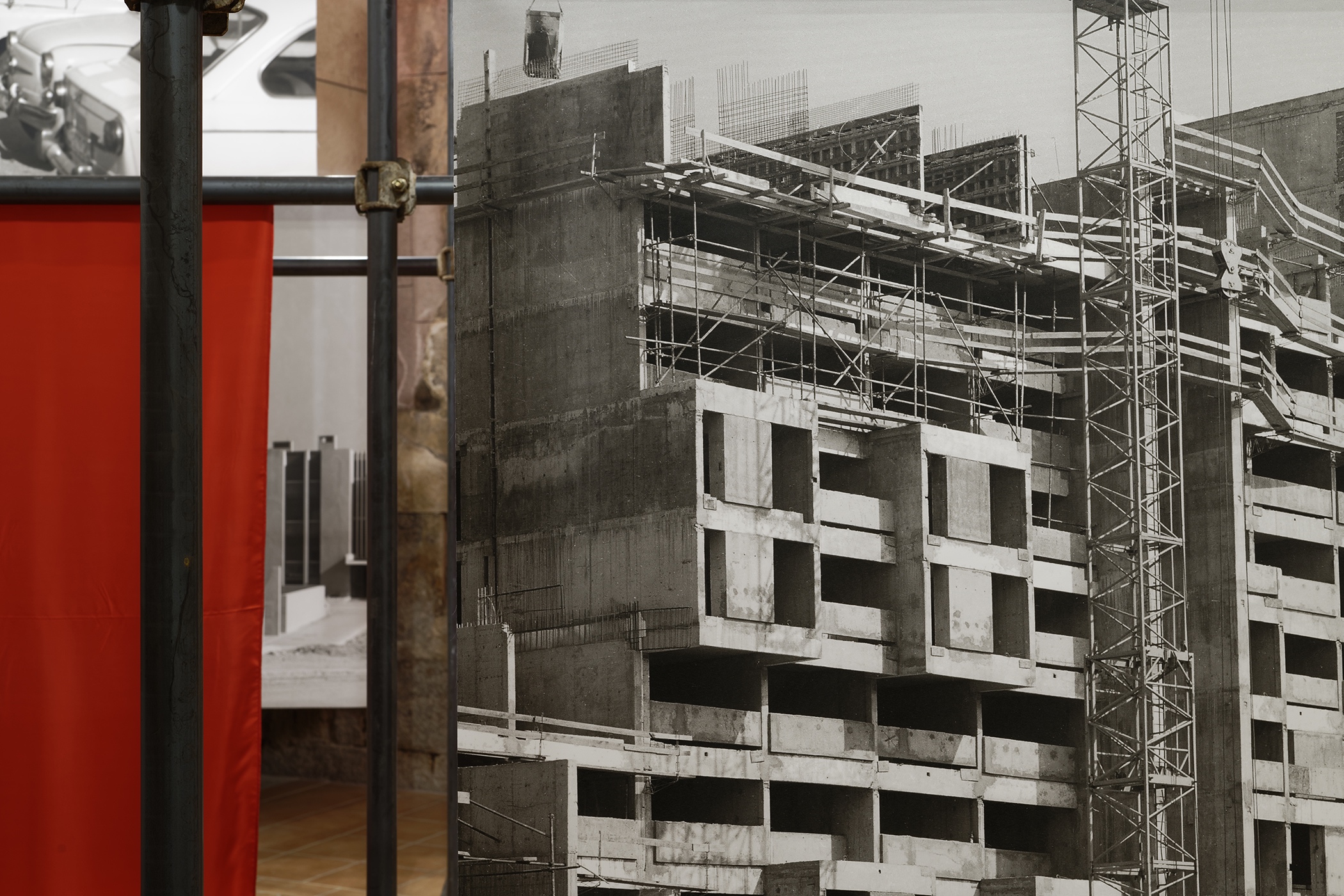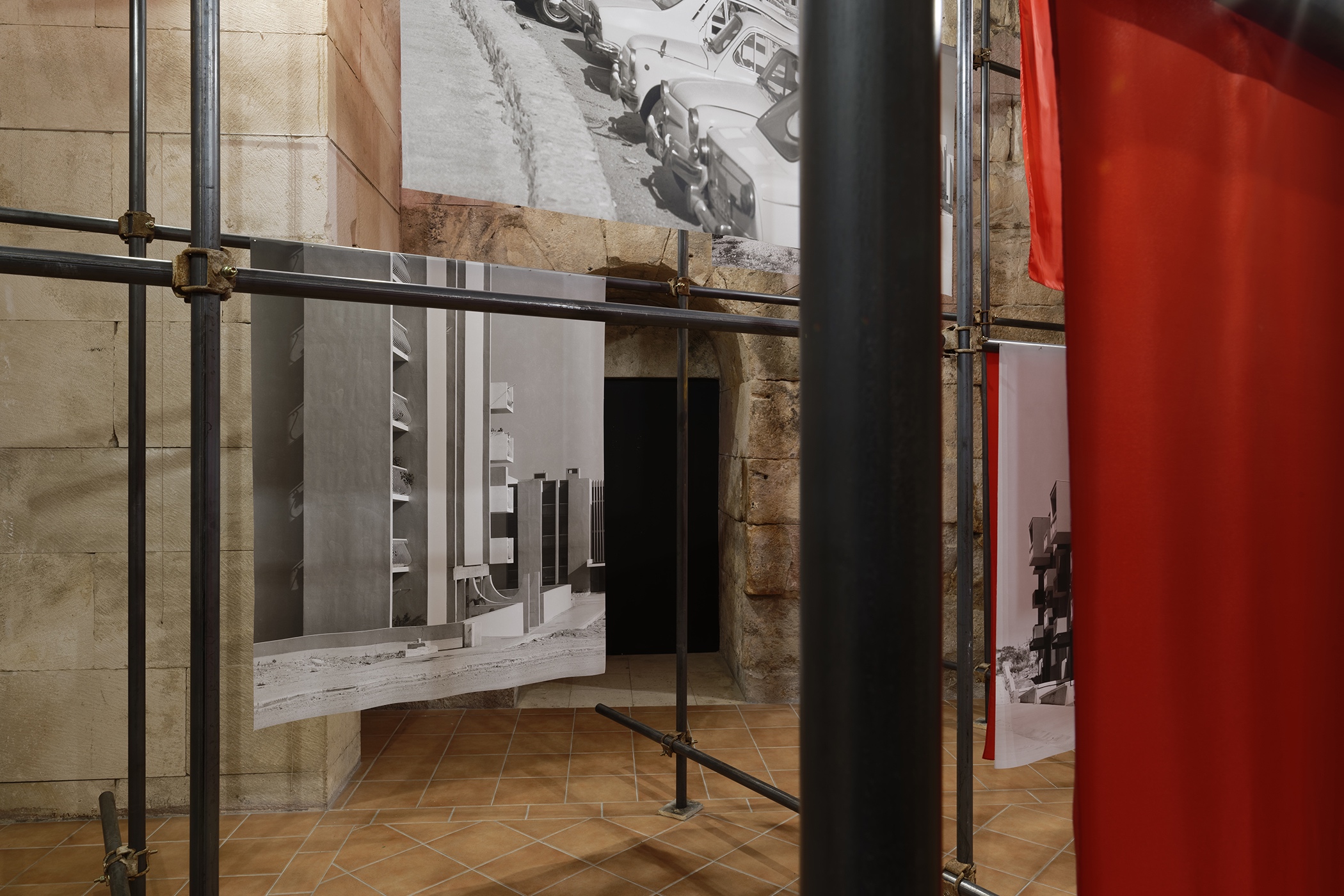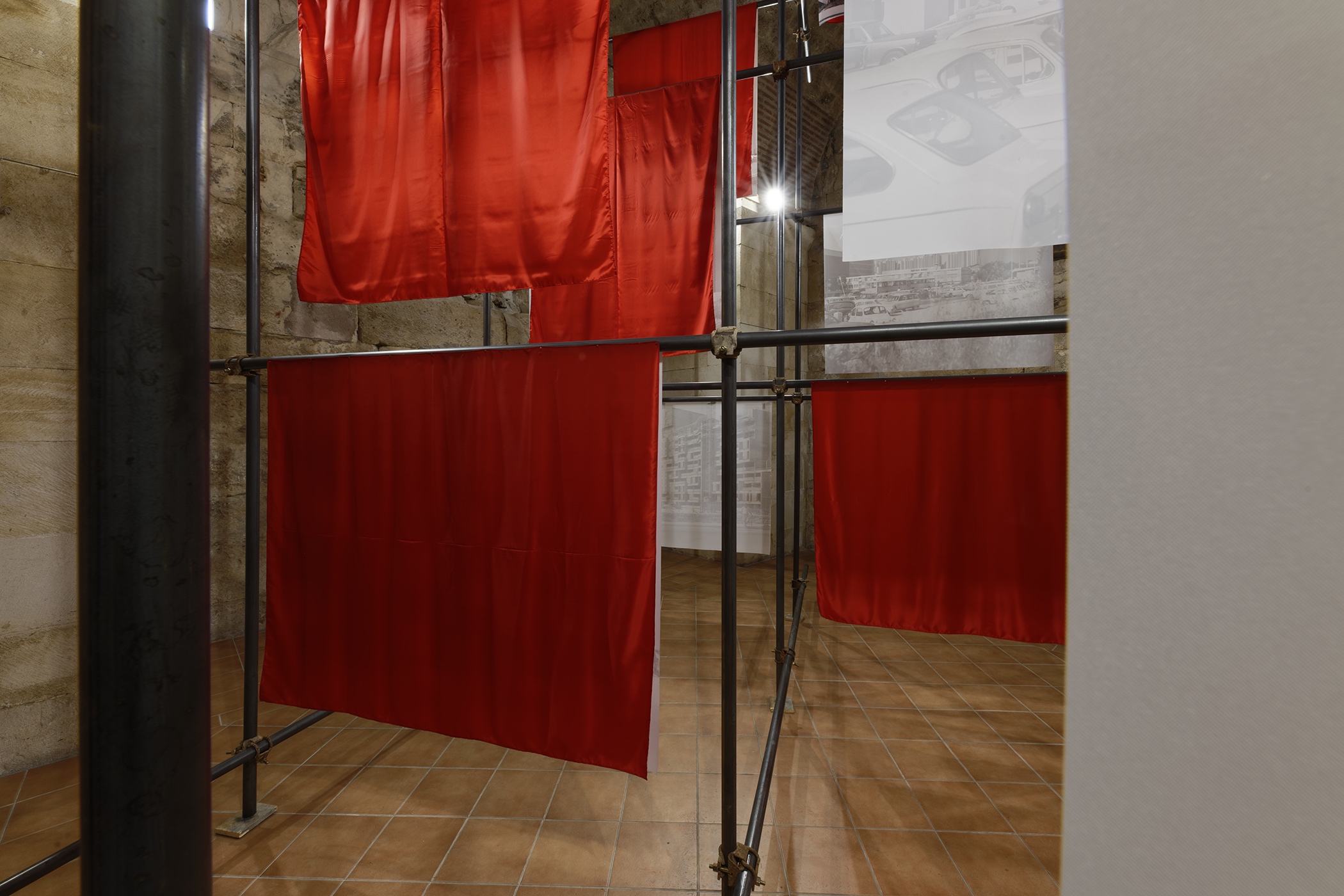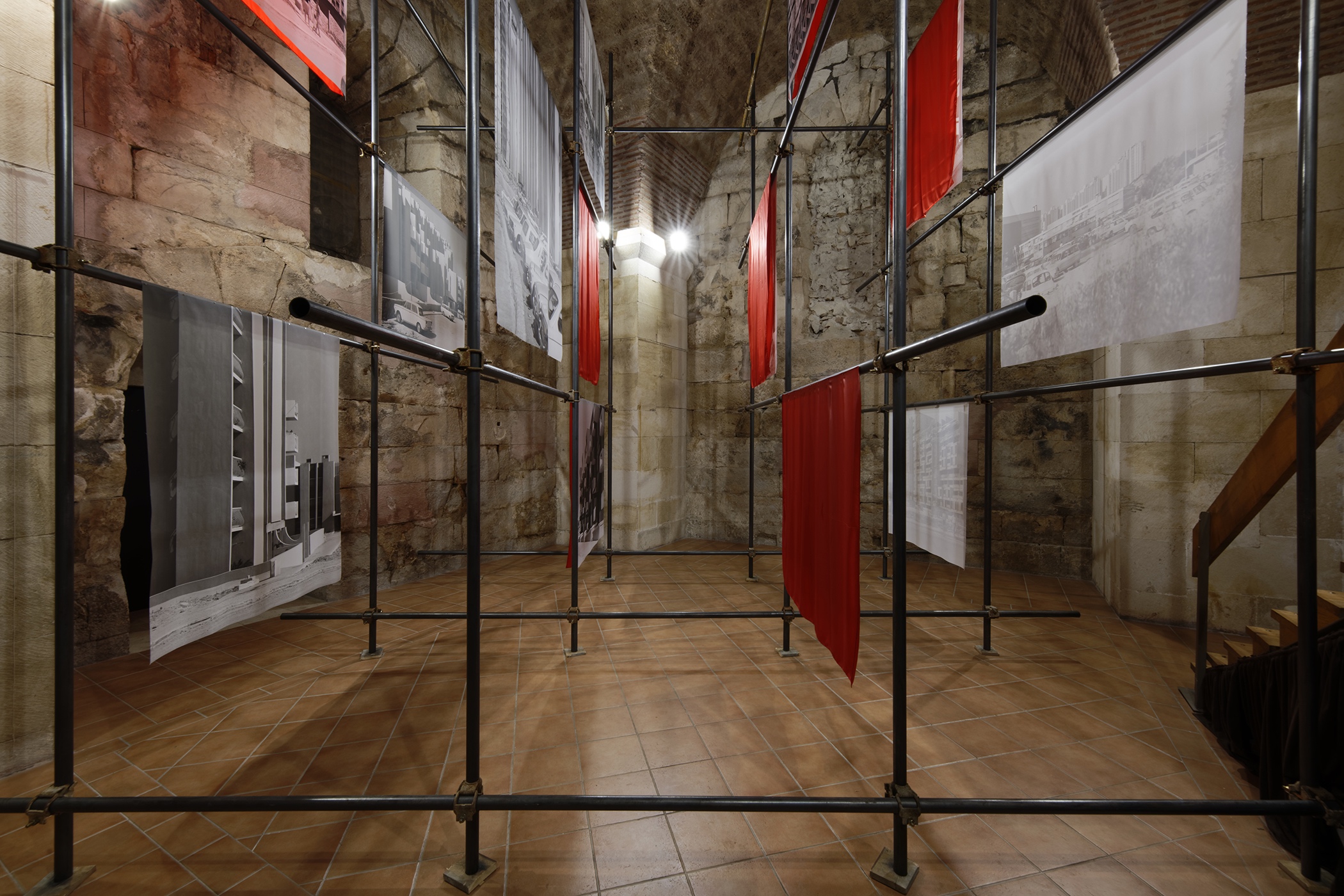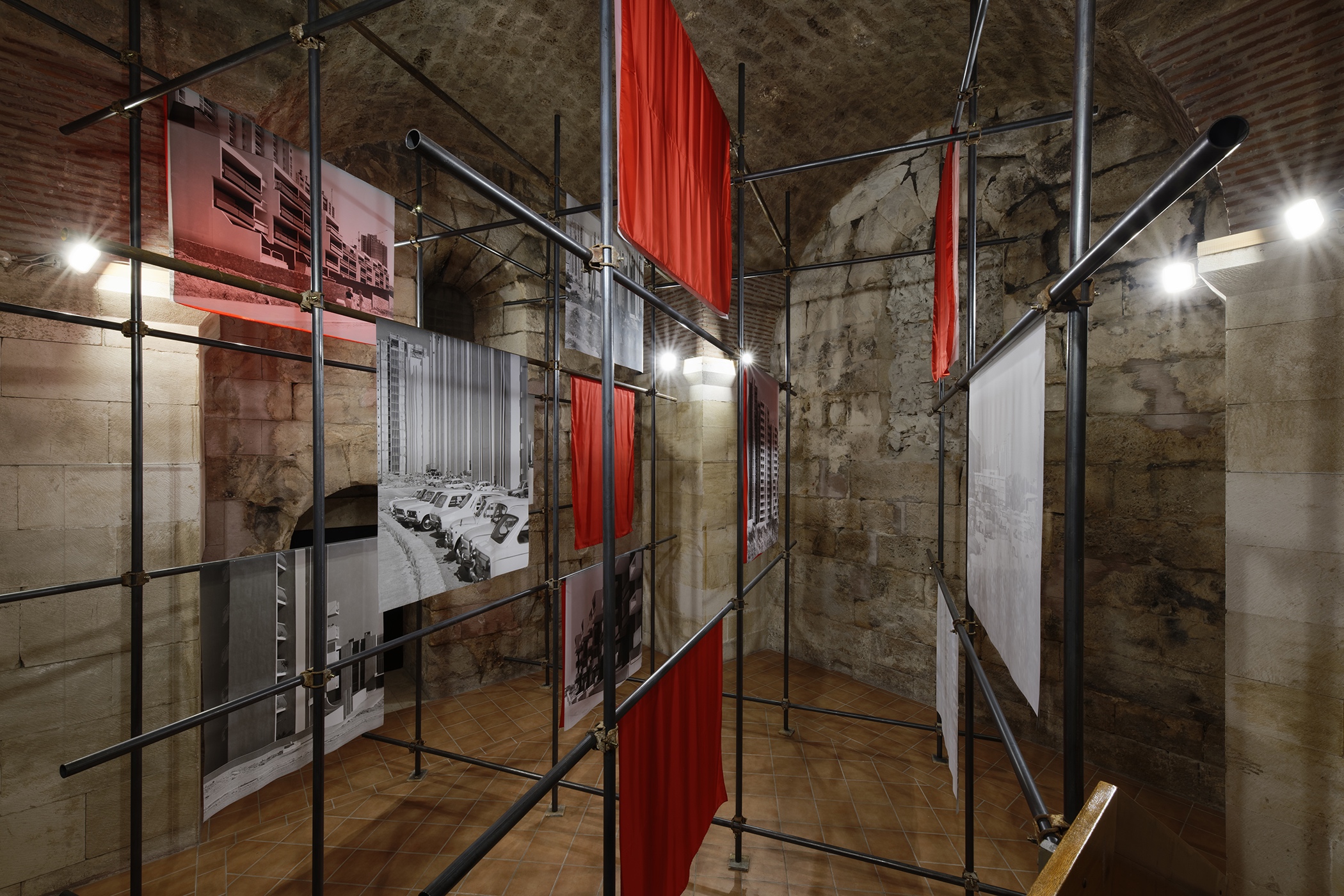Jasminka Babić
36 Degrees of Meaning
The city as a thematic or motivic framework of artistic research is often the focus of contemporary practices that, whether dealing with architectural, economic, social, or political aspects, seek to interpret the diverse parameters and complex relationships that make up the 21st-century city. Art thus becomes a legitimate place of interpretation, analysis, and/or critique, with artists being the ones who make extremely interesting observations and point out specific insights or knowledge that remain poorly visible in the quotidian, and often also professional discourse. This is especially true when speaking of Viktor Popović’s work, an artist from Split whose subject in recent years has been the architectural and urban heritage from the late Modern period through his works based on archival material. So, in this exhibition project that unites two distant and at first glance completely disparate locations – the Faculty of Humanities and Social Sciences building in Split and the Kula Gallery exhibition space – he highlights probably the most curious aspect of Split’s urbanity, and that is the continuity of thought that shaped the living space on the Split peninsula from the pre-Diocletian period until the latter half of the 20th century.
Let us, therefore, begin with the work installed on the façade of the Faculty of Humanities and Social Sciences, the former Brodomerkur building, whereupon Popović applies textual segments taken from one of the source documents of the Split 3 project – Basic Urban Design, which in 1969 presented the construction concept of the new eastern part of the city where the faculty building is located. In the context of Popović’s artistic work, the location and content of this intervention are obvious, if we consider the fact that the artist has been working with different segments of the Split 3 project since 2015. He uses the considerable collected archival material in his works and focuses on concepts and design of the urban planning project and architecture that was created in this period of large-scale modernization of the city. What is noteworthy in this regard is that the project largely determined the appearance and functioning of much of today’s Split, which is the artist’s starting point, and he juxtaposes the present-day post-transition situation with the one originally envisaged by the project. This strategy becomes especially visible when the artist can present the work in public space, wherein the relationship between the original concept and the present-day executed urbanization is extremely animated and set up for the observer’s consideration.
The second exhibition location of the Kula Gallery is entirely different from the public space of the faculty building and its façade. It is a specific exhibition space situated in the north-western tower of Diocletian’s Palace, in the heart of the city’s historic center. For this space, Popović has designed a large spatial installation made of scaffolding upon which he mounts large-format photographs, alternating them with red canvases of the same size. The black-and-white archival photographs by renowned Split photographer Zvonimir Buljević, who was involved in the Split 3 construction project as a technical contributor, were taken in the early 1970s in the newly built parts of Trstenik and Smrdečac districts. They show some of the most recognizable examples of residential buildings within Split 3, and since the photographs were taken immediately after the construction had finished, the original surfaces of the façades and volumes of architecture can be read and convey the basic idea behind the architectural rationale. At the same time, Buljević documented the time when new residents were moving in, amid the still unfinished environment of residential buildings. The relationship between contemporary architecture and the Mediterranean landscape is particularly pronounced, and the city can be seen taking over the areas of former vineyards and fields. These photographs represent the most obvious connection with the first exhibition location, but the installation itself hides another extremely interesting, even if somewhat more subtle link. Specifically, the scaffolding that forms the basic skeleton of the installation is rotated in relation to the layout of the Kula Gallery space, which in turn is part of the geometric system of the Palace. More precisely, the structure is shifted by exactly 36 degrees to overlap with the original direction of the ancient centuriation – the geometric organization of space that divided the entire Salonitan ager. Popović thus makes a “correction” of sorts, because he refers to the fact that the regular raster of the centuriation was neglected during the construction of Diocletian’s Palace so that the new structure would adapt to the slope of the terrain. On the other hand, this strategy refers to 20th-century urban planners who decided, when designing the Split 3 project, to use the remnants of the Roman centuriation to define the roads and orientation of most of the apartment blocks, which, after all, is what the textual segment written on the façade of the Faculty of Humanities and Social Sciences discusses. With this skillfully elaborated artistic strategy, Popović connects the specific architectural and spatial phenomena of both locations, thereby conveying the story of the intertwined historical and contemporary layers of present-day Split.
Observing the installation in the Kula Gallery, we should remember that Viktor Popović is an artist who is exceptionally adept at transforming the gallery space precisely through the medium of spatial installation. As a result of a considered approach to the formal and conceptual properties of the space in which he exhibits, Popović always produces works that, with their ambiguity, function both at the intellectual, but also experiential level of perception. For, the newly established relationship between the installation and the ancient structure of the exhibition space creates a dynamic that is impossible not to perceive, even if the observer does not know the context of the space he is entering. In the definition of movement through the erected scaffolding and the gradual perception of that which forms the artwork space, Popović comes close to ‘total installation’ – a term used by the Russian artist Ilya Kabakov to emphasize the immersive quality of installation art. Of course, working in a historically layered space such as the Kula Gallery is not foreign to Popović. In his 2013 intervention produced for the 38th Split Salon, he partitioned the Split City Museum space by erecting a wall in the exact position where the wall that defined Cardo Street in the original version of Diocletian’s Palace once stood. In the Kula Gallery, he uses the specific memory of the location in the same way, thereby creating an important relation between historical layers and changes in the conception of space, and those that define the city today. A city that is much more than the collection of ordinary commonplaces, a city that lives and thinks beyond the superficial interpretation of the residential imperial palace. A city that protects its historical core and does not allow it to be exploited at the expense of losing continuity of life, is what ultimately defined it. And it is in this context that the re-established relationships between different epochs, spaces, and reflections, activated by Viktor Popović’s work, are extremely important for the promotion of a smarter conception of the present-day and future city.
36 Degrees of Meaning
The city as a thematic or motivic framework of artistic research is often the focus of contemporary practices that, whether dealing with architectural, economic, social, or political aspects, seek to interpret the diverse parameters and complex relationships that make up the 21st-century city. Art thus becomes a legitimate place of interpretation, analysis, and/or critique, with artists being the ones who make extremely interesting observations and point out specific insights or knowledge that remain poorly visible in the quotidian, and often also professional discourse. This is especially true when speaking of Viktor Popović’s work, an artist from Split whose subject in recent years has been the architectural and urban heritage from the late Modern period through his works based on archival material. So, in this exhibition project that unites two distant and at first glance completely disparate locations – the Faculty of Humanities and Social Sciences building in Split and the Kula Gallery exhibition space – he highlights probably the most curious aspect of Split’s urbanity, and that is the continuity of thought that shaped the living space on the Split peninsula from the pre-Diocletian period until the latter half of the 20th century.
Let us, therefore, begin with the work installed on the façade of the Faculty of Humanities and Social Sciences, the former Brodomerkur building, whereupon Popović applies textual segments taken from one of the source documents of the Split 3 project – Basic Urban Design, which in 1969 presented the construction concept of the new eastern part of the city where the faculty building is located. In the context of Popović’s artistic work, the location and content of this intervention are obvious, if we consider the fact that the artist has been working with different segments of the Split 3 project since 2015. He uses the considerable collected archival material in his works and focuses on concepts and design of the urban planning project and architecture that was created in this period of large-scale modernization of the city. What is noteworthy in this regard is that the project largely determined the appearance and functioning of much of today’s Split, which is the artist’s starting point, and he juxtaposes the present-day post-transition situation with the one originally envisaged by the project. This strategy becomes especially visible when the artist can present the work in public space, wherein the relationship between the original concept and the present-day executed urbanization is extremely animated and set up for the observer’s consideration.
The second exhibition location of the Kula Gallery is entirely different from the public space of the faculty building and its façade. It is a specific exhibition space situated in the north-western tower of Diocletian’s Palace, in the heart of the city’s historic center. For this space, Popović has designed a large spatial installation made of scaffolding upon which he mounts large-format photographs, alternating them with red canvases of the same size. The black-and-white archival photographs by renowned Split photographer Zvonimir Buljević, who was involved in the Split 3 construction project as a technical contributor, were taken in the early 1970s in the newly built parts of Trstenik and Smrdečac districts. They show some of the most recognizable examples of residential buildings within Split 3, and since the photographs were taken immediately after the construction had finished, the original surfaces of the façades and volumes of architecture can be read and convey the basic idea behind the architectural rationale. At the same time, Buljević documented the time when new residents were moving in, amid the still unfinished environment of residential buildings. The relationship between contemporary architecture and the Mediterranean landscape is particularly pronounced, and the city can be seen taking over the areas of former vineyards and fields. These photographs represent the most obvious connection with the first exhibition location, but the installation itself hides another extremely interesting, even if somewhat more subtle link. Specifically, the scaffolding that forms the basic skeleton of the installation is rotated in relation to the layout of the Kula Gallery space, which in turn is part of the geometric system of the Palace. More precisely, the structure is shifted by exactly 36 degrees to overlap with the original direction of the ancient centuriation – the geometric organization of space that divided the entire Salonitan ager. Popović thus makes a “correction” of sorts, because he refers to the fact that the regular raster of the centuriation was neglected during the construction of Diocletian’s Palace so that the new structure would adapt to the slope of the terrain. On the other hand, this strategy refers to 20th-century urban planners who decided, when designing the Split 3 project, to use the remnants of the Roman centuriation to define the roads and orientation of most of the apartment blocks, which, after all, is what the textual segment written on the façade of the Faculty of Humanities and Social Sciences discusses. With this skillfully elaborated artistic strategy, Popović connects the specific architectural and spatial phenomena of both locations, thereby conveying the story of the intertwined historical and contemporary layers of present-day Split.
Observing the installation in the Kula Gallery, we should remember that Viktor Popović is an artist who is exceptionally adept at transforming the gallery space precisely through the medium of spatial installation. As a result of a considered approach to the formal and conceptual properties of the space in which he exhibits, Popović always produces works that, with their ambiguity, function both at the intellectual, but also experiential level of perception. For, the newly established relationship between the installation and the ancient structure of the exhibition space creates a dynamic that is impossible not to perceive, even if the observer does not know the context of the space he is entering. In the definition of movement through the erected scaffolding and the gradual perception of that which forms the artwork space, Popović comes close to ‘total installation’ – a term used by the Russian artist Ilya Kabakov to emphasize the immersive quality of installation art. Of course, working in a historically layered space such as the Kula Gallery is not foreign to Popović. In his 2013 intervention produced for the 38th Split Salon, he partitioned the Split City Museum space by erecting a wall in the exact position where the wall that defined Cardo Street in the original version of Diocletian’s Palace once stood. In the Kula Gallery, he uses the specific memory of the location in the same way, thereby creating an important relation between historical layers and changes in the conception of space, and those that define the city today. A city that is much more than the collection of ordinary commonplaces, a city that lives and thinks beyond the superficial interpretation of the residential imperial palace. A city that protects its historical core and does not allow it to be exploited at the expense of losing continuity of life, is what ultimately defined it. And it is in this context that the re-established relationships between different epochs, spaces, and reflections, activated by Viktor Popović’s work, are extremely important for the promotion of a smarter conception of the present-day and future city.
2021
Untitled (Archive ST3: Content)
solo exhibition
Kula Gallery, Split, Croatia
January 19 – February 19, 2021
curator:
Jasminka Babić
—
work exhibited:
Untitled (Archive ST3: Content), 2021
digital prints on canvas, canvas, scaffolding,
600 x 600 x 600 cm
archive photographs: private archive
(photographer: Zvonimir Buljević)
—
photo credits:
Viktor Popović
solo exhibition
Kula Gallery, Split, Croatia
January 19 – February 19, 2021
curator:
Jasminka Babić
—
work exhibited:
Untitled (Archive ST3: Content), 2021
digital prints on canvas, canvas, scaffolding,
600 x 600 x 600 cm
archive photographs: private archive
(photographer: Zvonimir Buljević)
—
photo credits:
Viktor Popović
14.04.2025.
© 2025 Viktor Popović
- Viktor Popović
- Exhibitions
- 2024 | Waldinger Gallery, Osijek
- 2024 | Apoteka – Space for Contemporary Art, Vodnjan
- 2024 | Technical Museum Nikola Tesla, Zagreb
- 2024 | Croatian Home, Split
- 2023 | Josip Račić Gallery, Zagreb
- 2023 | Filodrammatica Gallery, Rijeka
- 2023 | Ravne Gallery, Ravne na Koroškem
- 2023 | C24 Gallery, New York
- 2022 | A:D: Curatorial, Berlin
- 2021 | Faculty of Humanities and Social Sciences, Split
- 2021 | Cultural Institution Kula Gallery, Split
- 2020 | Health Center, Omiš
- 2020 | Armory Show, New York
- 2019 | Waldinger Gallery, Osijek
- 2019 | University Gallery Vasko Lipovac, Split
- 2019 | Museum of Fine Arts, Split
- 2018 | AŽ Gallery – Žitnjak Studios, Zagreb
- 2018 | C24 Gallery, New York
- 2017 | Multimedia Cultural Center, Split
- 2017 | Museum of Contemporary Art, Zagreb
- 2017 | Cukrarna Palace, Ljubljana
- 2015 | Salon Galić Gallery, Split
- 2015 | School Gallery, Split
- 2014 | MAP – Meeting Art Place, Brela
- 2014 | Billboard, Cista Provo
- 2013 | Split City Museum Gallery, Split
- 2013 | Lauba – People and Art House, Zagreb
- 2011 | Goli&Bosi Hostel, Split
- 2011 | City Lodge, Zadar
- 2011 | Museum of Fine Arts, Split
- 2010 | Richter Collection, Zagreb
- 2010 | St. Toma Gallery, Rovinj
- 2010 | Museum of Contemporary Art, Zagreb
- 2009 | Fonticus Gallery, Grožnjan
- 2008 | Mestrović Pavillion, Zagreb
- 2008 | The Old Printshop, Pula
- 2008 | Marganovo / Hartera, Rijeka
- 2008 | Glyptotheque, Zagreb
- 2008 | Multimedia Cultural Center, Split
- 2007 | Bačvice Aquarium, Split
- 2006 | Portland Art Center, Portland
- 2006 | City Reading Room, Komiža
- 2006 | Glyptotheque, Zagreb
- Projects
- 2024 | Untitled (Archive Fine Arts Museum)
- 2024 | Untitled (Archive Pharmacy)
- 2024 | Untitled (Archive Lynotipe)
- 2024 | Untitled (Archive Croatian Home)
- 2023 | Untitled (Archive Vranyczany-Dobrinović Palace)
- 2023 | Untitled (Archive Filodrammatica)
- 2023 | Untitled (Archive Ravne Steelworks)
- 2023 | Untitled (Monuments Archives)
- 2022 | Untitled (Archive Aperto Raum)
- 2021 | Untitled (Archive ST3: Content)
- 2021 | Untitled (Archive ST3: Content)
- 2020 | Untitled (Archive Omiš: Health Center)
- 2020 | Untitled (Archive Zenčišće)
- 2019 | Untitled (Archive ST3: Military Hospital)
- 2018 | Untitled (Archive ST3: Content)
- 2018 | Untitled (Archive ST3: Military Hospital)
- 2017 | Untitled (Archive ST3: Military Hospital)
- 2017 | Untitled
- 2015 | Untitled (Archive ST3)
- 2015 | Untitled
- 2014 | Untitled
- 2013 | Untitled
- 2011-2013 | Untitled
- 2011-2013 | Untitled
- 2007-2013 | Untitled
- 2007-2011 | Untitled
- 2010 | Untitled
- 2010 | Untitled
- 2009 | Untitled
- 2008 | Untitled
- 2008 | Untitled
- 2007 | Untitled
- 2007 | Untitled
- 2006 | Untitled
- 2006 | Untitled
- 2006 | Untitled
- Essays
- 2024 | Dalibor Prančević
- 2024 | Julija Gracin and Nevena Štokić
- 2024 | Ana Petković Basletić
- 2023 | Branko Franceschi
- 2023 | Sonja Jankov
- 2023 | Davor Mišković
- 2023 | Jernej Kožar
- 2022 | Adeline de Monseignat
- 2021 | Dalibor Prančević
- 2021 | Jasminka Babić
- 2020 | Jasminka Babić
- 2019 | Branka Benčić
- 2019 | Branko Franceschi
- 2017 | Nataša Ivančević
- 2017 | Jasminka Babić
- 2015 | Jasminka Babić
- 2014 | Jasminka Babić
- 2013 | Jasminka Babić
- 2012 | Ksenija Orelj and Sabina Salomon
- 2011 | Jasminka Babić
- 2008 | Ksenija Orelj
- 2007 | Klaudio Štefančić
- 2004 | Jasminka Babić
- 2004 | Dalibor Prančević
- CV
- Contact
- Sitemap
© 2025 Viktor Popović
